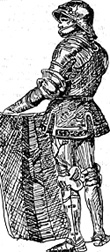The four Valois Dukes of Burgundy were able men. After a century of patient labor the Dukes had created a major European power which reached from the Alps to the North Sea. The French Kings and the German Emperors strove in vain to halt the growth of that power. In its prime Burgundy was one of the richest, most cultured and most powerful states of Europe.
 Charles the Bold, last Valois Duke of Burgundy, was the only ruler of his day to dimly see the revolution in warfare caused by gunpowder. Through a process of trial and error, combined with careful analytical meditation, Charles created an army that bridged the Medieval and
Renaissance periods. His military establishment has been called the "first modern army", and it generally influenced European military development.
Charles the Bold, last Valois Duke of Burgundy, was the only ruler of his day to dimly see the revolution in warfare caused by gunpowder. Through a process of trial and error, combined with careful analytical meditation, Charles created an army that bridged the Medieval and
Renaissance periods. His military establishment has been called the "first modern army", and it generally influenced European military development.
ARMY AND UNIT ORGANIZATION
Before Charles the Burgundian army resembled those of other European states. Orders of battle surviving from the reign of Duke John the Fearless reveal that Burgundian forces were composed of Feudal levies, mercenaries and allies in about equai proportions. In 1468 AD Charles started the creation of a standing army composed of volunteers and mercenaries.
The main building block of this new organization was the "lance team". A lance team was usually composed of eight or nine men. The composition varied somewhat over the years but most frequently consisted of a knight, page, coustilier, two or three mounted infantry archers, and three or four infantry. One hundred lance teams would combine to form an "Ordnance Company"-so called because they were governed by Ducal ordinances, or regulations. The Burgundian order of battle in 1472 may be considered typical.
There were twelve Ordinance Companies with the following strength: Knights: 1200; Coustiliers: 1200; Mounted Archers: 3000; Foot Crossbows: 600; Foot Archers: 1000; Pikemen: 2000; Handgunners: 600; Total: 9,600 combatants. This total excludes artillery, mercenaries not absorbed into the Ordinance and the local/short term feudal levies which were still used. The troops were usually organized into units of about 100 men, although understrength or overstrength situations are known. Knights and Coustiliers were brigaded together.
The Ordinance Companies were very flexible combined-arms organizations. Numerous combinations were possible and tried. Sometimes the Knights would dismount and intermingle with the foot archers, the pikes would intermingle with the archers, etc.
Charles' military ordinances painstakingly spelled out the when and how of training, the chain of command and duties of the officers, troop conduct and unit coordination. The full time paid status of the troops, their officering, and the compulsory drill and maneuvers qualify them as "regulars"
The pressure of the Swiss war caused Charles to reorganize the Ordinance Companies into eight divisions. Six of these divisions had 500 pikemen, 600 foot archers, 400 knights, 400 coustiliers and 800 mounted officers. One division had double the above number of infantry of various types and the last division was composed of Household troops.
TROOP EQUIPMENT AND UNIFORMS
Soldiers were expected to provide their own arms while the uniforms were provided by the State. Ordinances spelled out the minimum equipment required. Inspections were held frequently to ensure that the troops were properly equipped. It was not unusual for the soldiers to provide more arms and armor than the Ordinances required.
Knights supplied a complete suit of plate armor, three good horses, a combat saddle and chamfrain, lance and sword. Coustiliers brought a good javelin, a medium length single-handed sword, a foot long double edge dagger and horse. The mounted infantry archers were required to have a bow, thirty good arrows, long two handed sword and dagger.
The Ducal colors were blue and white. The knights were issued blue and white plumes for their heads and the heads of their horses. The knights were also given red velvet St. Andrew's crosses to place on their breastpiates. Coustiliers and mounted archers received a coat half blue and half white, although quartered blue and white was not unknown.
Infantry of the Ordinance used one handed swords and either a bow, crossbow, handgun or pike. Other infantry would be armed as the ordinance, although German mercenaries sometimes used polearms. Flemish infantry used pikes and word red caps. Dutch infantry used crossbows with the Dordrecht Levy wearing red and white hoods, while men from the Hague wore black hoods and Delft men wore white hoods. Most Italian infantry used crossbows. Brabant provided foot archers.
Mounted crossbows were supplied by the provence of Burgundy and Italians. English longbowmen were a popular and sought after mercenary, being armed and equipped as Ordinance mounted archers.
A large quantity of artillery characterized Burgundian armies. This reflected both Burgundian wealth and Charles' desire to have the best equipment possible.
Tube to men ratios ran from 1:120 to 1:200, which is a very high percentage of artillery for any period. It was proposed that camp followers and sappers be issued pikes and serve as battery guards, but I am unsure if this became a concrete practice.
The Ducal Army Standard was made of white taffeta with a picture of St. George, mounted on a horse, fighting the dragon which was breathing fire in all directions. The Standard bore the Duke's motto "Je l'ay emprins" (I have undertaken it), along with a St. Andrew's cross and other Burgundian emblems. The Household troops had similar standards, with St. George depicted as fighting on foot.
Wargaming the Burgundian Army
Back to Table of Contents -- Courier Vol. IV No. 2
© Copyright 1982 by The Courier Publishing Company.
This article appears in MagWeb (Magazine Web) on the Internet World Wide Web.
Other military history articles and gaming articles are available at http://www.magweb.com